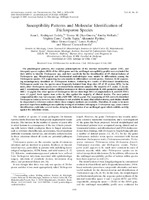Please use this identifier to cite or link to this item:
http://sgc.anlis.gob.ar/handle/123456789/220| DC Field | Value | Language |
|---|---|---|
| dc.contributor.author | Rodríguez-Tudela, Juan L. | es |
| dc.contributor.author | Diaz-Guerra, Teresa M. | es |
| dc.contributor.author | Mellado, Emilia | es |
| dc.contributor.author | Cano, Virginia | es |
| dc.contributor.author | Tapia, Cecilia | es |
| dc.contributor.author | Perkins, Alexander | es |
| dc.contributor.author | Gomez-Lopez, Alicia | es |
| dc.contributor.author | Rodero, Laura | es |
| dc.contributor.author | Cuenca-Estrella, Manuel | es |
| dc.date.accessioned | 2012-10-18T04:47:27Z | - |
| dc.date.available | 2012-10-18T04:47:27Z | - |
| dc.date.issued | 2005-10 | - |
| dc.identifier.issn | 1098-6596 | - |
| dc.identifier.uri | http://sgc.anlis.gob.ar/handle/123456789/220 | - |
| dc.identifier.uri | http://aac.asm.org/content/49/10/4026.full.pdf+html | - |
| dc.description | Fil: Rodriguez-Tudela, Juan L. Instituto de Salud Carlos III. Servicio de Micología; España. | es |
| dc.description | Fil: Diaz-Guerra, Teresa M. Instituto de Salud Carlos III. Servicio de Micología; España. | es |
| dc.description | Fil: Mellado, Emilia. Instituto de Salud Carlos III. Servicio de Micología; España. | es |
| dc.description | Fil: Cano, Virginia. ANLIS Dr.C.G.Malbrán. Instituto Nacional de Enfermedades Infecciosas. Departamento de Micología; Argentina. | es |
| dc.description | Fil: Tapia, Cecilia. Universidad de Chile. Programa de Microbiología y Micología; Chile. | es |
| dc.description | Fil: Perkins, Alexander. Instituto de Salud Carlos III. Servicio de Micología; España. | es |
| dc.description | Fil: Gomez-Lopez, Alicia. Instituto de Salud Carlos III. Servicio de Micología; España. | es |
| dc.description | Fil: Rodero, Laura. ANLIS Dr.C.G.Malbrán. Instituto Nacional de Enfermedades Infecciosas. Departamento de Micología; Argentina. | es |
| dc.description | Fil: Cuenca-Estrella, Manuel. Instituto de Salud Carlos III. Servicio de Micología; España. | es |
| dc.description.abstract | The physiological patterns, the sequence polymorphisms of the internal transcriber spacer (ITS), and intergenic spacer regions (IGS) of the rRNA genes and the antifungal susceptibility profile were evaluated for their ability to identify Trichosporon spp. and their specificity for the identification of 49 clinical isolates of Trichosporon spp. Morphological and biochemical methodologies were unable to differentiate among the Trichosporon species. ITS sequencing was also unable to differentiate several species. However, IGS1 sequencing unambiguously identified all Trichosporon isolates. Following the results of DNA-based identification, Trichosporon asahii was the species most frequently isolated from deep sites (15 of 25 strains; 60%). In the main, other Trichosporon species were recovered from cutaneous samples. The majority of T. asahii, T. faecale, and T. coremiiforme clinical isolates exhibited resistance in vitro to amphotericin B, with geometric mean (GM) MICs >4 mug/ml. The other species of Trichosporon did not show high MICs of amphotericin B, and GM MICs were <1 mug/ml. Azole agents were active in vitro against the majority of clinical strains. The most potent compound in vitro was voriconazole, with a GM MIC </=0.14 mug/ml. The sequencing of IGS correctly identified Trichosporon isolates; however, this technique is not available in many clinical laboratories, and strains should be dispatched to reference centers where these complex methods are available. Therefore, it seems to be more practical to perform antifungal susceptibility testing of all isolates belonging to Trichosporon spp., since correct identification could take several weeks, delaying the indication of an antifungal agent which exhibits activity against the infectious strain. | es |
| dc.format | application/pdf | ES |
| dc.language.iso | en | es |
| dc.publisher | American Society for Microbiology | es |
| dc.relation.ispartof | Antimicrobial agents and chemotherapy | es |
| dc.rights | info:eu-repo/semantics/openAccess | en_US |
| dc.rights | Open Access | - |
| dc.rights | Creative Commons Attribution 4.0 International License | - |
| dc.rights.uri | http://creativecommons.org/licenses/by/4.0/ | - |
| dc.source | Antimicrobial Agents and Chemotherapy, 2005, 49(10), 4026–4034. | en_US |
| dc.subject | Trichosporon | es |
| dc.subject | Farmacorresistencia Fúngica | es |
| dc.title | Susceptibility Patterns and Molecular Identification of Trichosporon Species | es |
| dc.type | Artículo | es |
| dc.identifier.doi | 10.1128-AAC.49.10.4026-4034.2005 Free PMC article | - |
| anlis.essnrd | 1 | es |
| item.openairetype | Artículo | - |
| item.grantfulltext | open | - |
| item.cerifentitytype | Publications | - |
| item.fulltext | With Fulltext | - |
| item.languageiso639-1 | en | - |
| item.openairecristype | http://purl.org/coar/resource_type/c_18cf | - |
| Appears in Collections: | snrd Publicaciones INEI | |
Files in This Item:
| File | Description | Size | Format | |
|---|---|---|---|---|
| AntimicrobialAgentsandChemotherapy,2005,49(10),4026–4034..pdf | Artículo de inglés | 128.98 kB | Adobe PDF |  View/Open |
Page view(s)
163
checked on Dec 15, 2025
Download(s)
73
checked on Dec 15, 2025
Google ScholarTM
Check
Altmetric
Altmetric
This item is licensed under a Creative Commons License


